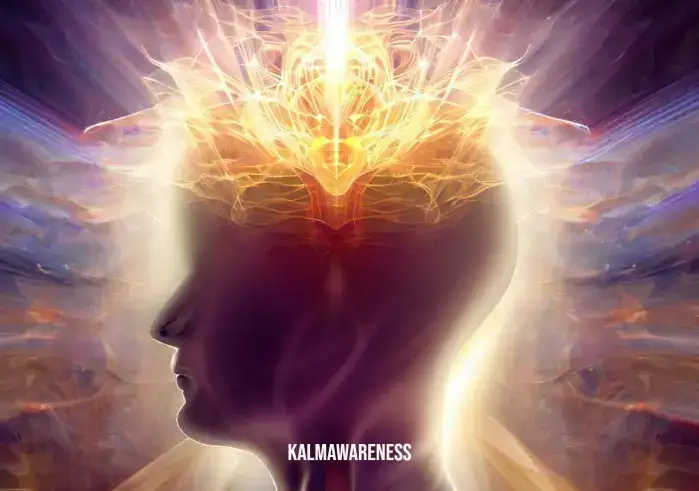Meditation Head Pressure: Finding Relief and Tranquility
Explore Effective Techniques and Practices to Alleviate Meditation Head Pressure
Have you ever experienced a sensation of pressure in your head while meditating? If so, you’re not alone. Many individuals encounter a phenomenon known as “meditation head pressure,” which can range from mild discomfort to a more intense sensation. In this article, we will delve into the causes of meditation head pressure and provide you with practical strategies to find relief and enhance your meditation practice.
Understanding Meditation Head Pressure
Meditation is a powerful tool for calming the mind, reducing stress, and promoting overall well-being. However, it’s not uncommon for practitioners to encounter certain physical sensations during their meditation sessions, including meditation head pressure. This sensation is often described as a feeling of tightness, heaviness, or a subtle throbbing in the head. While it can be disconcerting, it’s essential to understand that meditation head pressure is typically benign and temporary.
Causes of Meditation Head Pressure
There are several factors that can contribute to meditation head pressure. Let’s explore some of the common causes:
- Increased Blood Flow: During meditation, the body undergoes a state of relaxation, which can lead to improved blood circulation. The increase in blood flow to the brain and head region may result in a sensation of pressure.
- Focused Attention: When we engage in meditation, we direct our attention inward, focusing on the breath, mantra, or an object of meditation. This heightened focus can create a subtle energy buildup, which may manifest as head pressure.
- Release of Tension: Meditation often facilitates the release of physical and mental tension. As stress and anxiety melt away, you may experience a temporary release of stored tension, which could contribute to sensations of pressure in the head.
- Energetic Shifts: In certain meditation practices, such as mindfulness and energy-based techniques, individuals may encounter shifts in their subtle energy or prana. These energetic shifts can generate sensations in various parts of the body, including the head.
While these causes provide a general understanding of meditation head pressure, it’s important to remember that each individual’s experience may vary. It’s crucial to pay attention to your body and practice self-awareness during meditation.
Techniques to Relieve Meditation Head Pressure
Experiencing head pressure during meditation does not necessarily indicate a problem; however, if it becomes uncomfortable or persistent, you may wish to explore techniques to alleviate the sensation. Here are some effective strategies to find relief:
1. Deep Breathing and Relaxation
One of the simplest and most accessible techniques to alleviate meditation head pressure is deep breathing. Take slow, deep breaths, inhaling through your nose and exhaling through your mouth. Visualize the tension leaving your body with each exhale, allowing your mind and muscles to relax fully.
2. Body Scan Meditation
A body scan meditation involves systematically focusing your attention on different parts of your body, bringing awareness to any tension or discomfort. Begin at the top of your head and gradually move down to your toes, releasing any physical or mental tension you encounter along the way. This practice can help release any head pressure and promote overall relaxation.
3. Visualization and Imagery
Imagery exercises can be a powerful tool to shift your attention away from head pressure. Picture yourself in a serene natural setting, such as a peaceful beach or a lush forest. Engage your senses and imagine the gentle breeze, the soothing sounds, and the warmth of the sun. Allow this visualization to transport you to a state of tranquility and ease.
4. Grounding Techniques
Grounding techniques can help you connect with the present moment and alleviate head pressure. Focus on the sensation of your feet firmly planted on the ground. Imagine roots extending from your feet, reaching deep into the earth, anchoring you and providing stability. Embrace the feeling of being grounded and supported by the earth.
5. Balancing Energies
If you resonate with the concept of subtle energy or prana, you can explore practices that aim to balance the energy in your body. One such practice is alternate nostril breathing. Close your right nostril with your thumb and inhale deeply through your left nostril. Then, close your left nostril with your ring finger and exhale through your right nostril. Repeat this process, alternating nostrils for several minutes. This technique can help restore harmony and alleviate head pressure caused by energetic imbalances.
These techniques offer you a starting point to find relief from meditation head pressure. Remember, each individual is unique, and what works for one person may not work for another. It’s essential to explore different practices and techniques to discover what resonates with you.
In the next part of this article, we will dive deeper into the significance of meditation head pressure and explore how it can be addressed through specific meditation techniques and approaches. We will also discuss how a balanced and mindful approach to meditation can enhance your overall well-being and provide lasting benefits. Continue reading here to gain valuable insights and guidance on navigating meditation head pressure effectively.

Exploring the Significance of Meditation Head Pressure and Effective Meditation Techniques
Discover the Meaning behind Meditation Head Pressure and Harness the Power of Effective Techniques
In the previous section, we discussed the causes of meditation head pressure and explored various techniques to alleviate this sensation. Now, let’s delve deeper into the significance of meditation head pressure and how it can be addressed through specific meditation techniques and approaches.
Embracing the Message of Meditation Head Pressure
Meditation head pressure, despite its temporary discomfort, can offer valuable insights into your practice. Instead of perceiving it as a hindrance, consider it as a message from your body and mind. This sensation often arises when you are on the verge of breaking through mental barriers or experiencing a deeper level of awareness. It serves as a reminder to remain present, grounded, and open to the transformative potential of your meditation journey.
Mindfulness-Based Approaches to Meditation Head Pressure
Mindfulness meditation is a powerful practice that cultivates non-judgmental awareness of the present moment. It can be particularly beneficial in addressing meditation head pressure. By adopting a mindful approach, you can observe the sensation without attaching any judgment or resistance to it. Instead of perceiving it as an obstacle, view it as an opportunity to deepen your practice and explore the inner workings of your mind and body.
During your meditation sessions, when you notice the presence of head pressure, gently direct your attention to the sensation itself. Observe its qualities—its location, intensity, and any associated thoughts or emotions that arise. Practice non-attachment and let go of any expectations or aversions towards the sensation. This mindful approach can foster a sense of curiosity and acceptance, allowing you to navigate through meditation head pressure with greater ease.
Integrating Breath Awareness
The breath is a powerful anchor that can help you cultivate focus, presence, and relaxation. Incorporating breath awareness techniques into your meditation practice can assist in alleviating meditation head pressure. As you sit in meditation, bring your attention to the natural rhythm of your breath—observe its gentle inhales and exhales.
During moments of head pressure, gently shift your focus to the sensation of your breath entering and leaving your body. Allow the breath to serve as a soothing balm, gradually easing any discomfort or tension. Embrace the rhythmic flow of your breath as you inhale tranquility and exhale any sensations of pressure. This integration of breath awareness can harmonize your mind, body, and spirit, creating a serene and balanced inner landscape.
Visualization and Release
Visualization techniques can be potent tools for addressing meditation head pressure. Picture the sensation of pressure in your head as a tangible object or energy. Imagine holding it in your hands or visualizing it as a cloud of mist. As you exhale, visualize releasing this pressure, allowing it to dissolve and disperse into the atmosphere.
Alternatively, you can visualize a gentle stream of cool water flowing through your head, washing away any sensations of pressure and bringing a sense of clarity and lightness. Combine this visualization with deep, intentional breaths, inhaling freshness and exhaling any tension or discomfort. This visualization and release approach can help you find relief and create a more harmonious meditation experience.
Embracing Stillness and Silence
In the midst of meditation head pressure, it can be beneficial to embrace moments of stillness and silence. Instead of attempting to push through or distract yourself from the sensation, pause and surrender to the present moment. Allow yourself to sit in quiet contemplation, accepting the sensations as they arise.
During these moments of stillness, you may notice subtle shifts within your body and mind. Embrace the opportunity to cultivate a deeper connection with your inner self and explore the vastness of your consciousness. This practice of embracing stillness and silence can lead to a profound sense of peace and clarity, ultimately diminishing the intensity of meditation head pressure.
As you continue on your meditation journey, remember that meditation head pressure is a natural part of the process for many practitioners. It signifies the opening of new pathways and the potential for growth. By applying mindfulness, breath awareness, visualization, and stillness, you can navigate through meditation head pressure with grace and find a deeper sense of tranquility and presence.
Continue reading here to explore a comprehensive meditation lesson plan that incorporates techniques to address meditation head pressure effectively. Discover structured practices and guidance to deepen your meditation practice and unlock profound states of calm and self-discovery.

Unlocking the Secrets to Meditation Head Pressure and Cultivating Inner Bliss
Discover the Path to Inner Bliss as You Explore the Profound Secrets Behind Meditation Head Pressure
In the previous sections, we have explored the causes of meditation head pressure and discussed various techniques to find relief and enhance your meditation practice. Now, let’s dive even deeper into the secrets behind meditation head pressure and uncover the transformative potential it holds. By understanding these secrets, you can unlock the door to inner bliss and profound self-discovery.
The Gateway to Expanded Awareness
Meditation head pressure serves as a gateway to expanded awareness and heightened states of consciousness. When you encounter this sensation, it signifies that you are on the verge of accessing deeper layers of your being. Embrace the head pressure as a sign of progress on your meditative journey, a sign that you are moving closer to a profound connection with your true self.
Exploring Energetic Centers
Meditation head pressure often indicates the activation and alignment of energetic centers within the body. These centers, commonly referred to as chakras, are swirling vortexes of energy that correspond to different aspects of our physical, emotional, and spiritual well-being. The sensation of head pressure can be an indication of energy flowing and harmonizing in the upper chakras, particularly the crown chakra and third eye chakra.
By embracing meditation head pressure, you are opening yourself up to a deeper understanding of your energetic body. This awareness allows you to explore and balance the subtle energies within, leading to a greater sense of harmony and alignment in all aspects of your life.
The Role of Breath in Alleviating Head Pressure
Breath is not only a powerful anchor for your meditation practice but also a key element in alleviating meditation head pressure. The rhythmic and intentional flow of breath can help regulate energy and release any blockages or tension that may contribute to head pressure.
As you focus on your breath during meditation, invite a sense of spaciousness and ease into your inhalations and exhalations. Imagine that each breath carries healing energy and gently massages the areas of your head where you feel pressure. Visualize the breath expanding and dissolving any discomfort or constriction, creating a sense of relief and relaxation.
Cultivating Equanimity and Non-Attachment
Meditation head pressure can sometimes trigger feelings of discomfort or unease. It is important to approach these sensations with equanimity and non-attachment. By cultivating a mindset of non-reactivity and acceptance, you allow the sensations to arise and pass without clinging to them or identifying with them.
As you meditate, observe the sensations of head pressure without judgment or resistance. Acknowledge their presence, but do not become entangled in them. Instead, maintain a sense of spacious awareness, knowing that these sensations are temporary and part of your unique meditative experience.
The Power of Mantra and Sound
Mantra and sound have long been used as tools for healing, transformation, and spiritual awakening. Incorporating the power of mantra into your meditation practice can help alleviate meditation head pressure and deepen your connection with the divine.
Choose a mantra that resonates with you, such as “Om” or any other sacred sound that holds personal significance. As you repeat the mantra silently or aloud, feel the vibrations permeating your entire being, including the area of your head where you experience pressure. Allow the soothing and harmonizing effect of the mantra to dissolve any discomfort and create a sense of inner peace.
Embracing the Journey of Self-Discovery
Meditation head pressure is not an obstacle to overcome but rather an invitation to embark on a profound journey of self-discovery. As you navigate through this sensation, remember that meditation is a practice of exploration, self-observation, and growth.
Embrace the opportunity to delve deeper into your own consciousness and gain insights into the workings of your mind and body. Approach meditation head pressure with curiosity and openness, knowing that it is a signpost on your path to inner transformation.
Continue reading here to explore the transformative power of meditation and gain inspiration from Minister McGhee’s personal journey with meditation head pressure. Discover firsthand accounts and insights from a seasoned practitioner as you uncover the secrets to unlocking inner bliss and deep self-realization.

Unveiling the Healing Potential of Meditation Head Pressure and Exploring Techniques for Self-Healing
Tap into the Healing Power of Meditation Head Pressure and Discover Techniques to Foster Self-Healing
In the preceding sections, we’ve delved into the significance of meditation head pressure and explored various approaches to navigate through this sensation. Now, let’s unravel the hidden healing potential behind meditation head pressure and delve into techniques that promote self-healing. By harnessing these practices, you can unlock profound healing and well-being on your meditation journey.
Understanding the Healing Process
Meditation head pressure can be seen as a catalyst for healing, offering an opportunity to address and release deep-seated emotional and energetic blockages. It serves as a gentle nudge from your inner self, inviting you to embark on a transformative healing journey.
To tap into the healing potential of meditation head pressure, it is essential to approach it with mindfulness and self-compassion. Create a safe and nurturing space within your meditation practice, allowing yourself to explore and process any emotions or memories that may arise. Embrace the discomfort as a sign that healing is taking place, as you gently peel back the layers and release what no longer serves you.
Breathwork for Healing
The breath is a powerful tool for healing, and incorporating specific breathwork techniques into your meditation practice can amplify the healing potential of meditation head pressure. One such technique is pranayama, which involves conscious control and manipulation of the breath.
During meditation, as you encounter head pressure, focus on slow, deep inhalations and exhalations. Visualize the breath flowing into the areas of pressure, carrying healing energy and releasing any tension or blockages. As you exhale, imagine letting go of any stagnant energy, allowing it to dissipate into the universe. This intentional breathwork can facilitate the healing process and create a sense of inner harmony.
Body Awareness and Sensation
The body holds valuable wisdom and can be a gateway to healing. By cultivating body awareness during meditation, you can tap into the innate intelligence of your physical form and facilitate self-healing.
As you sit in meditation, direct your attention to the areas of your body where you feel meditation head pressure. Allow your awareness to rest upon these sensations without judgment or resistance. Observe any shifts or changes in the sensations and bring a sense of gentle curiosity to the experience.
By acknowledging and accepting these sensations, you create a space for healing and release. Trust in your body’s innate ability to restore balance and well-being as you continue to explore the depths of your meditation practice.
Visualization for Healing and Release
Visualization techniques can be potent tools for self-healing, especially when combined with meditation head pressure. Engage your imagination to create visual images that represent healing and release.
During meditation, visualize a brilliant, healing light entering through the crown of your head and flowing down into the areas of pressure. Imagine this light dissolving any tension or discomfort, transforming it into pure, radiant energy. As you exhale, visualize releasing this transformed energy, allowing it to disperse and merge with the expansive universe.
By repeatedly engaging in this visualization practice, you are consciously programming your mind and body for healing, rejuvenation, and the integration of new, positive energy.
Journaling for Self-Reflection and Integration
Journaling can be a powerful tool for self-reflection and integration during your meditation journey. Take a few moments after your meditation sessions to write down any insights, emotions, or experiences related to meditation head pressure.
As you journal, you may uncover patterns, memories, or realizations that provide deeper understanding and healing. This process of self-reflection allows you to integrate the lessons and wisdom gained from meditation head pressure, bringing them into your daily life.
Seeking Professional Guidance
While meditation can be a transformative tool for self-healing, it is important to acknowledge that some experiences may benefit from professional guidance. If meditation head pressure becomes overwhelming or persists for an extended period, consider seeking support from a qualified meditation teacher, therapist, or healthcare practitioner who specializes in holistic healing.
These professionals can offer guidance tailored to your specific needs, helping you navigate through the intricacies of meditation head pressure and facilitating your healing journey.
Continue reading here to explore the profound practice of meditation on acceptance. Discover how acceptance can be a powerful ally in your healing process, and gain insights into practices that foster self-acceptance, compassion, and growth.

Nurturing Joy Through Meditation and Embracing the Transformational Power of Meditation Head Pressure
Discover the Path to Joy and Embrace the Profound Transformation Enabled by Meditation Head Pressure
In our exploration of meditation head pressure, we have uncovered its significance and explored techniques for finding relief and fostering self-healing. Now, let’s embark on a journey of nurturing joy through meditation and fully embracing the transformative power of meditation head pressure. By integrating joy into our practice and embracing the transformation it offers, we can experience profound growth and fulfillment.
Cultivating Joy in Meditation
Meditation provides a fertile ground for cultivating joy within ourselves. By intentionally directing our attention and focusing on positive emotions, we can harness the transformative power of meditation head pressure to nurture a deep sense of joy and well-being.
During meditation, when you encounter head pressure, shift your focus to the sensations of joy and happiness within your body. Allow these sensations to expand and radiate throughout your being, enveloping your entire being in a cocoon of positive energy. Embrace the experience with gratitude and let it infuse your practice with lightness and bliss.
Gratitude and Appreciation
Practicing gratitude and appreciation is a powerful way to nurture joy during meditation. Take a moment to reflect on the blessings in your life, both big and small. Express gratitude for the opportunity to practice meditation and the transformative journey it offers. As you focus on gratitude, you invite joy to flourish and permeate every aspect of your being.
Loving-Kindness Meditation
Loving-kindness meditation, also known as metta meditation, is a practice of cultivating love, compassion, and well-wishes towards ourselves and others. By integrating loving-kindness meditation into your practice, you can enhance your capacity for joy and compassion, even in the face of meditation head pressure.
As you meditate, silently repeat phrases of loving-kindness such as “May I be happy. May I be peaceful. May I be filled with joy.” Extend these wishes to others as well, gradually expanding the circle of love and compassion. This practice opens the heart, nurturing a profound sense of joy and interconnectedness.
Embracing Impermanence
Meditation head pressure reminds us of the impermanent nature of all phenomena, including our experiences and sensations. Embracing the impermanence of head pressure allows us to cultivate a deeper sense of joy and freedom. Just as the pressure arises, it also passes away.
During meditation, observe the sensation of head pressure with a sense of curiosity and non-attachment. Recognize that it is simply a temporary experience, arising and dissolving within the ever-changing landscape of your meditation practice. Embracing impermanence empowers us to find joy in the present moment and appreciate the fluidity of our experiences.
Surrendering to the Process
Surrendering to the process of meditation head pressure is a transformative act of trust and letting go. Rather than resisting or seeking to control the sensations, surrendering allows us to fully immerse ourselves in the journey and embrace its transformative potential.
During your meditation sessions, when head pressure arises, surrender to the experience. Release any expectations or desires for a specific outcome. Instead, surrender to the wisdom of your body and the guidance of your inner self. Allow the sensation to unfold and guide you on a path of self-discovery and growth.
Integrating Meditation into Daily Life
The benefits of meditation extend far beyond the time we spend on our cushions. Integrating meditation into our daily lives allows us to carry the joy and transformative power of meditation head pressure into every aspect of our existence.
As you go about your daily activities, be mindful and present. Cultivate a sense of joy and appreciation for the simple pleasures of life. Allow the wisdom and insights gained from meditation to inform your actions and interactions with others. By integrating meditation into your daily life, you create a ripple effect of joy and transformation that extends beyond the boundaries of your formal meditation practice.
Continue reading here to explore the profound practice of meditation on joy. Gain insights into techniques and approaches that nurture joy and discover how the cultivation of joy can empower you to embrace the transformative power of meditation head pressure.
Congratulations on completing this journey of exploring meditation head pressure and its profound potential for growth and transformation. May your continued meditation practice bring you deep joy, inner peace, and a profound connection with your true self.




